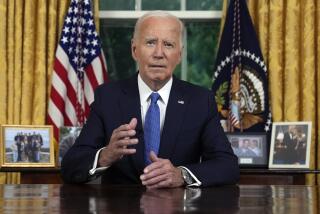Voters Reaching Limit on Term-Limit Issue
Long ago, circa 1990-94, all manner of evil was ascribed to that creature most foul, the career politician. Incumbency was an epithet. Washington, if not the ninth circle of hell, was a short cab ride away.
Then, more than two-thirds of the seats in Congress turned over. Democrats lost control of the House for the first time in 42 years. The economy--not incidentally--skipped merrily back from recession. Suddenly, political experience has become a virtue money can’t buy.
And just as suddenly, time has seemingly run out on the term-limits movement and its appeal to the discontented masses.
Indeed, this season of the status quo has brought repeated setbacks for term-limit advocates, who’ve seen their efforts--and several favored candidates--run aground in congressional contests from Oregon to Pennsylvania.
In the June primary, California voters approved a term-limits measure that was ignored throughout the campaign. It was purely symbolic (urging congressional approval) and plainly unconstitutional. A follow-up version intended to fix the flaws couldn’t even muster the signatures to make the November ballot.
“Term limits are a has-been,” said Stuart Rothenberg, who tracks hot issues in hundreds of congressional races for his Washington-based political newsletter. “It’s over. It’s toast.”
“What was a cutting issue has become just another issue,” agreed Mark Mellman, a Democratic pollster in Washington.
“You don’t have people at the barricades demanding change when three out of four say, ‘Yeah, things are going all right,’ ” echoed Bill McInturff, a Republican counterpart.
To which Mark Petracca replies: Hooey.
The movement isn’t dead, insisted Petracca, a UC Irvine political science professor and one of the country’s foremost experts on term limits. It’s not dormant. It’s just different from before.
*
Eighteen states, including California, impose term limits on their state lawmakers, 38 on their governors. Scores of major cities have municipal term limits.
Various courts have upheld those assorted restrictions. (Judges have invalidated limits in three other states.) The problem, from the perspective of term-limit backers, comes at the federal level.
Essentially, the U.S. Supreme Court has decided that only Congress can approve congressional term limits, by passing a constitutional amendment and sending it to the 50 states for ratification.
This is not easy. Imagine handing someone a hammer and asking them, please, to drive a 5-inch nail through their forehead. There is, to say the least, a certain resistance.
In 1994, backing term limits as part of their “Contract With America,” Republicans won control of the House. Since then, members have voted twice on a constitutional amendment, falling well shy of approval on both occasions. The Senate has never taken up the issue.
And so, after winning a series of big statewide battles in the movement’s heyday, term-limit advocates have hunkered down for something more akin to trench warfare.
Their weapon is “the pledge,” a commitment sought from each congressional candidate to serve no more than three terms in the House and/or two in the Senate. The goal (or the theory, anyway) is to force gradual change from the outside instead of fighting the term-limits fight within Congress.
As case in point, Paul Jacob, head of U.S. Term Limits, cites the Sacramento-area race to replace longtime Democratic Rep. Vic Fazio, a staunch term-limits foe. Both of his would-be successors, Republican Doug Ose and Democrat Sandie Dunn, have taken “the pledge.”
“Cycle after election cycle,” Jacob vows, “we’re going to build a bloc within the Congress of truly term-limited people.”
*
Jacob and associates, however, have antagonized many erstwhile allies by taking an absolutist approach, opposing any candidate--even one favoring term limits--who won’t abide by their prescribed limits. “It’s the height of arrogance,” huffed Eddie Mahe, a veteran GOP strategist and co-founder of the term-limits movement, who now declares himself a sworn enemy of Jacob’s cause.
That infighting, along with today’s less-than-conducive political climate, suggests the movement, at the very least, faces a period of uncertainty. “They’ve won all the easy ones,” said Gary Jacobson, a UC San Diego congressional scholar. “Now they’re operating under harder circumstances.”
Still, women fought decades for the right to vote. It took more than 20 years to bring about the direct election of U.S. senators (before adoption of the 17th Amendment in 1913, senators were appointed by state legislatures.)
Any number of obituaries were written before adoption of the 17th Amendment, professor Petracca points out, much like today’s death notices for the term-limits movement.
Will the cause prove irresistible, a prairie fire rekindled at the first spark of voter upset? Or will the movement burn out, joining Reaganomics and Perot-mania on the decade’s ash heap of political discards? If history serves, the answer is years away.
More to Read
Get the L.A. Times Politics newsletter
Deeply reported insights into legislation, politics and policy from Sacramento, Washington and beyond. In your inbox three times per week.
You may occasionally receive promotional content from the Los Angeles Times.











